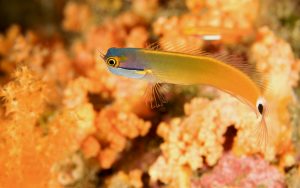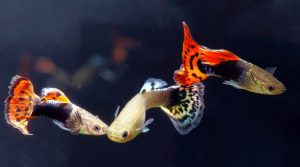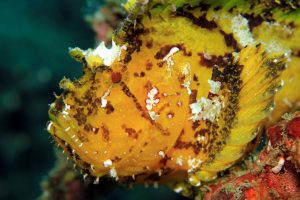Nano tanks are popular in the aquarium industry because they are convenient while still allowing hobbyists to obtain beautiful and graceful pets. Ranging from 5 gallons to 30 gallons, nano fish tanks can be placed on desks, in offices, in bedrooms, and on small stands.
If you are considering starting a nano reef tank, you may wish to know what types of saltwater fish and freshwater fish live well in these smaller environments.
Fortunately, you have many options, and they’re all good ones.
10 Best Saltwater Fish for Nano Reef Tanks
With a saltwater aquarium, you have many options for brightly colored, intriguing, and fun fish. Some of our favorite saltwater fish for nano reef tanks include:
- Pajama Cardinalfish
- Neon, Coral, Firefish, or Shrimp Goby
- Royal Gramma
- Orchid Dottyback
- Blue or Green Chromis
- Midas or Tailspot Blenny
- Clownfish
- Purple Firefish
- Pygmy Hawk
- Blue Spotted Jawfish (bottom dweller)

A tailspot blenny is ideal for a saltwater nano tank.
10 Best Freshwater Fish for Nano Tanks
If you would prefer freshwater fish, maintenance of the nano tank may be somewhat easier because freshwater fish are generally tougher. Here are some of the best freshwater fish for nano tanks:
- Neon or Cardinal Tetra
- Betta
- Harlequin or Chili Rasbora
- Guppy
- Zebra, Galaxy, or Celestial Pearl Danio
- Bluefin Notho Killifish
- Dwarf Puffer
- Bumblebee Goby
- Sparkling Gourami
- Salt-and-Pepper Cory (bottom dweller)

Guppies are popular for freshwater nano aquariums.
Not as Simple as It Looks
If you have never owned a fish tank, it may be tempting to try to start with a nano tank.
Keep in mind that a smaller tank will likely get dirty faster, as there is not as much water to help maintain a proper pH level. For that reason, regular water changes are crucial to the health of your fish and to maintain the beauty of your aquarium design.
Because it’s a small living space, it’s also important to choose fish that are likely to be compatible and to include components such as gravel and plants.
For assistance in nano tank maintenance or for general information, contact us at Seatech Aquariums.
![]()



